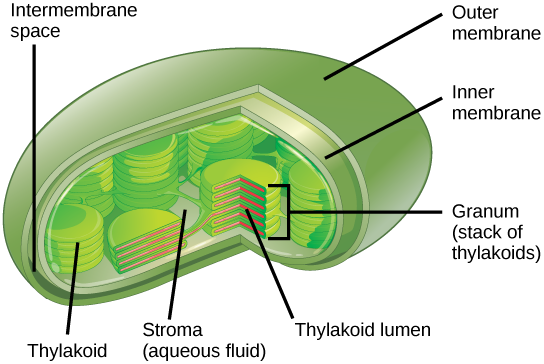
Draw the structure of chloroplast and label the parts.
Answer
565.5k+ views
Hint: Chloroplasts are membrane bound plastids that contain a network of membranes embedded into liquid matrix and contain chlorophyll which imparts green color to plants and helps in photosynthesis.
Complete answer:

Following are the parts of chloroplast:
1) Envelope or outer membrane- semi-porous in nature and permeable to small molecules and ions but it is not permeable to larger proteins.
2) Intermembrane space- it is a thin space of 10-20 nanometers which is present between the outer and inner membrane of chloroplast.
3) Inner membrane- it forms a border to the stroma. It helps in regulating the passage of materials in and out as well as regulates the fatty acids and lipids also synthesized in this membrane.
4) Stroma- it is an alkaline, aqueous fluid which is present within the inner membrane of the chloroplast. Space outside the thylakoid space is known as stroma.
5) Thylakoid system- it is suspended in the stroma. This system is a collection of membranous sacs known as thylakoids. They are arranged in stacks called grana. Each granum contains 10-20 thylakoids.
6) Peripheral reticulum- chloroplasts of some plants contain an additional set of membranous tubules known as peripheral reticulum which originates from the inner membrane. Tiny vesicles bud off from the inner membrane and form the tubules of the peripheral reticulum.
Note: All of the components of chloroplast participate in several functions of the cell. Chloroplasts also provide metabolic activities for plant cells.Chloroplasts are biconvex or plano convex in shape. It has different shapes like spheroid, filamentous, ovoid.
Complete answer:

Following are the parts of chloroplast:
1) Envelope or outer membrane- semi-porous in nature and permeable to small molecules and ions but it is not permeable to larger proteins.
2) Intermembrane space- it is a thin space of 10-20 nanometers which is present between the outer and inner membrane of chloroplast.
3) Inner membrane- it forms a border to the stroma. It helps in regulating the passage of materials in and out as well as regulates the fatty acids and lipids also synthesized in this membrane.
4) Stroma- it is an alkaline, aqueous fluid which is present within the inner membrane of the chloroplast. Space outside the thylakoid space is known as stroma.
5) Thylakoid system- it is suspended in the stroma. This system is a collection of membranous sacs known as thylakoids. They are arranged in stacks called grana. Each granum contains 10-20 thylakoids.
6) Peripheral reticulum- chloroplasts of some plants contain an additional set of membranous tubules known as peripheral reticulum which originates from the inner membrane. Tiny vesicles bud off from the inner membrane and form the tubules of the peripheral reticulum.
Note: All of the components of chloroplast participate in several functions of the cell. Chloroplasts also provide metabolic activities for plant cells.Chloroplasts are biconvex or plano convex in shape. It has different shapes like spheroid, filamentous, ovoid.
Recently Updated Pages
Why are manures considered better than fertilizers class 11 biology CBSE

Find the coordinates of the midpoint of the line segment class 11 maths CBSE

Distinguish between static friction limiting friction class 11 physics CBSE

The Chairman of the constituent Assembly was A Jawaharlal class 11 social science CBSE

The first National Commission on Labour NCL submitted class 11 social science CBSE

Number of all subshell of n + l 7 is A 4 B 5 C 6 D class 11 chemistry CBSE

Trending doubts
Differentiate between an exothermic and an endothermic class 11 chemistry CBSE

10 examples of friction in our daily life

One Metric ton is equal to kg A 10000 B 1000 C 100 class 11 physics CBSE

Difference Between Prokaryotic Cells and Eukaryotic Cells

1 Quintal is equal to a 110 kg b 10 kg c 100kg d 1000 class 11 physics CBSE

State the laws of reflection of light




